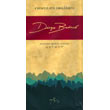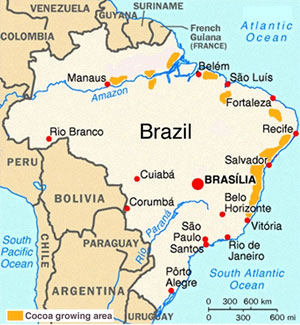 FLAVOR PROFILE: direct though less simple than conventionally thought; Earthen – mistaken as overall monochromatic (cocoa, coffee)… but quite region-dependent & variable with some cacáo types exhibiting feral fruit tones & big woods; can be both quite acidic & acrid, & yet with correct handling & control can also deliver strong baseline flavor with overarching nuance; solid body.
FLAVOR PROFILE: direct though less simple than conventionally thought; Earthen – mistaken as overall monochromatic (cocoa, coffee)… but quite region-dependent & variable with some cacáo types exhibiting feral fruit tones & big woods; can be both quite acidic & acrid, & yet with correct handling & control can also deliver strong baseline flavor with overarching nuance; solid body.
CHARACTERISTICS: typically grows an Amazon Amelonado-type workhorse – some of unremitting bulk quality (unless sun-dried which mellows its character, as opposed to harsher gas-fired) that many scornfully & erroneously label ‘Lower Amazon’
Once the world’s #1 producer, then decimated. Now on the rebound & roaring back.
China gave its name to a trading good – porcelain; Brazil received its from one – brazilwood a/k/a dyewood, a tree used for making bows to play musical string instruments, as well as the dye Natural Red #24. Together, these two nations are poised to be the world’s biggest trading partners.
Large enough to be its own continent, Brazil contains the lion’s share of the Amazon River Basin. Once the #1 cacáo exporter in the world, its industry buckled under devastating diseases with accusations swirling about that they were maliciously released amid local political conflicts. Biological terrorism in effect, rekindling the feud / fight / specter of burning down cacáo groves dramatized in Jorge Amado’s book The Violent Land. The twin scourge of Witches Broom & Black Pod indirectly contributed to rampant deforestation during the last half century, particularly the virulent outbreak in 1989, compounded by a collapse in the price of cocoa on world commodity markets. By the early ‘90s over three-quarters of its crop lay decimated, turning the landscape into a kind of war zone between feuding factions & large landholding families amidst a forest-in-ruins, making the country a net importer of what it once owned.
The felling & clearing of trees for brazilwood made way for first manioc, then coffee, cacáo & ultimately the railroad that cut ever deeper into the Mata Atlântica coastal forest, creating a limited number of uniform crops which in the short-run may be easier to prune but at gains fraught with adverse long-term consequences. To illustrate, picking cacáo pods is difficult & nerve-wracking in a jungle terrain that naturally slows down even the fastest worker who has to wander from tree to tree that sparsely dot the forest floor in search of it among a jumble of other trees, climbing vines, & entangled creepers… not to mention fending off wild animals. The efficient solution trades the forest thriving with diverse flora for the productivity of a monoculture sun plantation.
This too has costs, as Henry Ford learned the expensive way: a built-in greenhouse effect.
In 1927, he incorporated more than 2.5 million acres, roughly the size of Tennessee, inside Brazil’s Amazon River Basin to cultivate Hevea brasiliensis – latex trees tapped for their sap to make rubber so Ford cars can run on tires… & complete the vertical integration of his auto empire. Instead it all went flat, & with it a large tract of the rainforest turned into a mud hole.
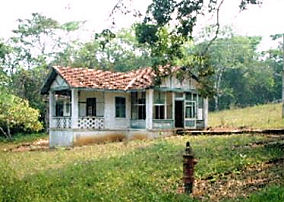 Written about by Greg Grandin, Fordlândia was a utopian-city in the jungle transplanting an Americana Disney-fantasy overlaid on razed Amazonia wilderness. A real-life saga of Twain’s Huck Finn meets Conrad’s Heart of Darkness with neatly-paved streets sporting Model-Ts, prefab houses, manicured lawns (including a golf course), movies theaters, hamburger stands, ice-cream shops & weekend socials often featuring polka dances.
Written about by Greg Grandin, Fordlândia was a utopian-city in the jungle transplanting an Americana Disney-fantasy overlaid on razed Amazonia wilderness. A real-life saga of Twain’s Huck Finn meets Conrad’s Heart of Darkness with neatly-paved streets sporting Model-Ts, prefab houses, manicured lawns (including a golf course), movies theaters, hamburger stands, ice-cream shops & weekend socials often featuring polka dances.
Nature ultimately rebelled.
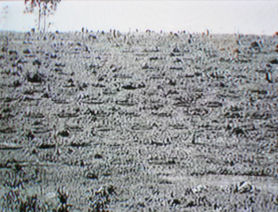 For starters, direct sunlight on open plantations, cleared away of the forest canopy cover, heats up exposed water – the perfect breeding ground to incubate viruses & bacteria in an outdoor Petri dish of sorts. Next, monoculture trees were planted by engineers instead of botanists in the same way Ford placed machines right next to each other back home in his auto factory in Michigan, hoping to mechanize the jungle into an assembly-line. Neatly lined-up in congested rows of 200 trees per acre as opposed to about 7 in the Amazon’s natural ecology, they made easy work for pests to wreak havoc; nothing stops them in the way of a break or barrier from devouring one tree to the next. Add the fact that Ford originally purchased a relatively lame parcel of land – hilly with rather poor soil – only confabulated his woes. By 1945, synthetic rubber was discovered & the struggle was enough for him to leave his rubber trees after a caterpillar ate them all without Henry ever having set foot on his spectacular failure… virtually abandoned except for inhabitants like bats, vines & twines, plus encroaching soybean farms contributing to deforestation as surely as a wild brush fire.
For starters, direct sunlight on open plantations, cleared away of the forest canopy cover, heats up exposed water – the perfect breeding ground to incubate viruses & bacteria in an outdoor Petri dish of sorts. Next, monoculture trees were planted by engineers instead of botanists in the same way Ford placed machines right next to each other back home in his auto factory in Michigan, hoping to mechanize the jungle into an assembly-line. Neatly lined-up in congested rows of 200 trees per acre as opposed to about 7 in the Amazon’s natural ecology, they made easy work for pests to wreak havoc; nothing stops them in the way of a break or barrier from devouring one tree to the next. Add the fact that Ford originally purchased a relatively lame parcel of land – hilly with rather poor soil – only confabulated his woes. By 1945, synthetic rubber was discovered & the struggle was enough for him to leave his rubber trees after a caterpillar ate them all without Henry ever having set foot on his spectacular failure… virtually abandoned except for inhabitants like bats, vines & twines, plus encroaching soybean farms contributing to deforestation as surely as a wild brush fire.
Not altogether lost is the Ford vision of a regimented jungle. It moved upriver & can more or less be found in the free-trade zone of Manaus where Harley, Nokia, & Sony have set up shop.
Ford’s teachable-experiment shows that in their natural habitats plants deal with adversity in an ongoing drama of evolutionary adaptation that improves the breed & builds up resistance to predators in a gradual way thru a shared history together. Pathogens in the wild form a symbiosis with their hosts to mimic the vaccine principle. Essentially, a bargain gets struck: “I let you infect me but don’t kill me”. Massive deforestation works against this & against biodiversity; causing erosion, infestation & over-cultivation to the point of ruination. In other words, an ecological wasteland. Stripped of protection from surrounding foliage, plants deteriorate & lose their vigor. Denuded of that buffer capacity, they become vulnerable & ill suited to shocks. As a result, around only 10% of the virgin Mata Atlântica still stands today. What’s left is mostly depleted, & agriculture there is heavily dependent on intensive farming methods, pesticides & petroleum-based fertilizers.
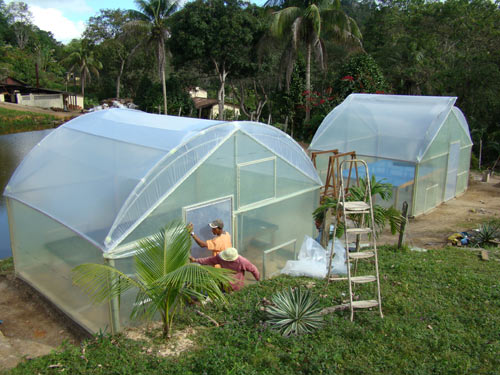 signs of rebirth – mobile drying sheds
signs of rebirth – mobile drying sheds
Brazil’s cacáo popularly subdivides between the ‘Lower’ & ‘Upper’ Amazon (the latter, due to encroaching deforestation, becoming evermore the heartland of the Amazon). The much-maligned reputation of ‘Lower Amazon’ seems unjustified in view of the fact that diseases, aggravated by disruptive rubber exploitation, means very little cacáo actually grows there today. The bulk of Brazil’s output is well south of the Amazon in the States of –
a) Pará (centered around the town of Cametá) – an unforgiving environment for cacáo stuck in heavy soils, forced to contend with the strangling root system of the Babaçu palm tree. According to Dr. Basil Bartley, who specialized on Brazil & probably knew as much as anyone about its cacáo diversity during his lifetime, Pará forms part of the ‘Amazon Extension’, outside of cacáo’s natural habitat seeing how the region’s generally poor soil & nutrient conditions are unsuitable for the plant to thrive.
Some credit João de Ornellas da Câmara as the first person to plant cacáo in Pará for cultivation in the 1670s; others claim the Jesuits. Whatever the truth, the business got rolling here by Jesuit missionaries. While Carmelites & to lesser extent Mercedarians & even Franciscans dabbled with cacáo, the Jesuits embraced it to dominate the trade among religious orders. As the militant wing of the Church during the Counter-Reformation, Jesuits marched worldwide in search of souls for conversion. A lethal combination of industriousness & scholarship, they operated as botanists & brokers in the lucrative cacáo trade to finance their religious activities. Huge chocolate drinkers themselves, cacáo probably first attracted their attention for medicinal reasons, especially the extracted cocoa butter’s healing properties. Jesuits set up infirmaries & pharmacies, selling it for profit to give rise to the saying ‘where there’s a church, there’s chocolate’.
All this partially explains why they fought Dominican friars so hard over whether drinking it violated the Lenten Fast. Pope Gregory XIII proved to be their ever-staunch ally. He sided with them in a decree & henceforth chocolate was allowed ad maiorem Dei gloriam (for the greater glory of God), remarkable in light of the modern Church exhorting the flock to give up sexting & all electronic distractions during periods of abstinence.
The Jesuits employed a mix of slave & wage labor. They sheltered Túpi inhabitants away from bandeirantes (slave raiders, usually Portuguese settlers though native enemies of the Túpi also engaged in the practice that typically ransomed captives for trading goods) in missions known as reductiones which dotted the countryside in the hopes of literally planting a “Jesuit Republic”. Rumors on them abounded that priests rang bells in the middle of the night to signal the natives that it was ‘procreation times’ for making the next generation of Christians. In exchange, the Túpi, who intimately knew the lay of the land, went out to harvest wild-cacáo in the rainforest.
Reductiones proved a persistent sore point. Discord between the Church & the Colonists (Black Robe vs. White Settlers) simmered over Jesuit opposition to enslavement & their efforts on behalf of all Amerinds, though mainly Túpis, to work out better labor terms with settlers. Economically the Jesuits could afford to do so because the Spanish crown exempted them from taxes. Settlers argued that the reductiones only impoverished Amerinds who’d otherwise labor under free-market enterprises (i.e., slavery)!
Widespread commercial cultivation in the country first took place along the Rio Mojú & was in full operation by 1700, growing a type probably sourced from the Jesuit mission at the mouth of Rio Madeira. Not to be completely outdone, the Carmelite nuns built a cacáo farm on Marajó Island. The Jesuits centered their activities in the college at Belém. An accounting dated to 1728 lists all but 2% of their cacáo coming from feral trees in the Amazon jungle – figures hotly contested by settlers’ claims that it was the other way around in an attempt to get their holy rivals out of commerce & back into spiritual duties only which would theoretically free up Amerind workers for their plantations. Somewhat wishful thinking considering how Túpis loathed the settlers’ plantation conditions for cacáo they could just as easily pick in the wild.
The complaints of settlers sound hugely aggrandizing, a predatory ploy to seize more cocoa. Compared to secular merchants the Jesuit trade amounted to small beans. To cite just one metric, from 1756-77 the Campanhia do Grão Pará e Maranhão controlled a monopoly on river trade. Whoever controlled this trade were also in control of the riverbanks & the lives of the people along them.
Fast forward to today… Cametá, located just north of the mouth of the Rio Tocantins, remains the regional cultivation center & the area’s crop historically has displayed some variability, including a rather unusual green-colored Pentagonum fruit shape described in 1937 by the explorer F.J. Pound, plus fruits near Belém called ‘half blanco’, & a ‘central type’ generally identified as an Amelonado x Largarta (the latter of elongate / rough warty surface). That most of these are lumped under a catchall term like ‘Forastero’ defies the diversity recorded by Paul Le Cointe in 1934 & later confirmed by Bartley, from shapes to colors & scent/taste of the fruit pulp.
Of historical note, the first Brazilian cacáo to be exported to Europe came from Pará & it was the principal producing region in the country until the 1880’s when cacáo began to take off in Bahia;
b) Bahia (mainly around the former German colonial city of Ilhéus) – cacáo produced here is restricted to coastal areas & referred to as Comum (Portuguese for ‘common’) which sums up its status & quality (depending on post-harvest handling). Undocumented claims credit French settler Luiz Federico Warneau with transplanting seeds into southern Bahia along the Rio Pardo in 1746. Records show a German colonist named Steiger introducing seeds between 1874-1876, originally sourced in all probability from Rio Marañon (Peru) & Pará which back then referred to an area of the Amazon considerably larger than the current State of Pará, Brazil today. And in a tale of Ripley’s Believe It or Not™, Zehntner notes a Criollo he had imported from then Ceylan / present day Sri Lanka originating in Venezuela, crossed by plants bred in Nicaragua via Trinidad, all of which provides an illustration of just how mixed-up cacáo is. Here too the Jesuit played a consequential role. They devised the first plantations to systematically commoditize cacáo on their missionary coastal tracts: Olivença, just south of Ilhéus, where the Jesuit already established a sugar operation, another further south still at Canavieiras, & in the opposite direction a large mission about 50 miles north of Ilhéus at Camamu on the Trinidad River. Their methods proved so efficient that in time the region became the top cocoa producer in the world during the early 20th century.
Both Pará & Bahia are home to some estates growing a monoculture cacáo. It would be an oversimplification to call it all ‘Forastero’, or even the subvariant Comum, especially in light of specualtion about where its seedlings originate… from sources ranging widely between Peru & Trinidad. A strange irony considering a lot of Brazil’s enormous cacáo potential remains right in-country, untapped… locked deep inside remote, impenetrable reaches of the Amazon Rainforest:
 – Upper & Lower stretches of the Amazon exhibit some similar characteristics; the middle run – known as the Solimões – is rife however with variability. The area where the tributary Rio Japurá courses thru from bordering Colombia hosts some of the greatest diversity of the species.
– Upper & Lower stretches of the Amazon exhibit some similar characteristics; the middle run – known as the Solimões – is rife however with variability. The area where the tributary Rio Japurá courses thru from bordering Colombia hosts some of the greatest diversity of the species.
– At the eastern end of the Solimões near Rio Purús, the cacáo features sweet pulp & intensely aromatic seeds – even when dried & unfermented – a sign of high pedigree.
– Tucked away from the mainstream of other cacáo growing regions, rumors surrounding the Rio Ji-Parana basin down south boast of exceptionally high quality.
– Up north along the Rios Negro & Blanco thrives a staggering magnitude of unique Amelonado-type cacáo.
– Out west, reputed wild cacáo of high density can be found in the Javarí river valley where few people live. Supposedly of a different form (compared to other cacáo in the Amazon) & unique, to say the least, with an unheard-of blue tint on its fruit pods (literal ‘anthocyanin’, the Greek word for ‘blue flower’; antho = flower + cyan = blue). Reports of red-colored pods at the confluence with Rio Curuçá, as well as on the Rio Jandiatuba, suggest a variety similar though unconnected to Criollo.
All the above taken together shows Brazil can be a lot more than just the place where ‘Forastero’ got a bad name. Change is afoot: on-going research at Santa Cruz State University (UESC), plus the Centro de Pesquisas do Cacau gene bank in Itabuna, is readying some cultivars with heirloom ancestry in the hope of making Brazil synonymous with another quality… of the much higher variety.
Their labor is already bearing fruit. Cooperatives such as Cacauway right on the Trans-Amazonian Highway in Medicilândia, Pará have planted thousands of cacáo saplings & hundreds of other trees (mahagony, brazil nut & ipe) in a campaign to help preserve tracts in the Amazon threatened with deforestation. Another, headed up by Darcirio Vronski, of a couple dozen families harvest organic cacáo that finds its way into chocolate bars like Austrian barsmith Josef Zotter.
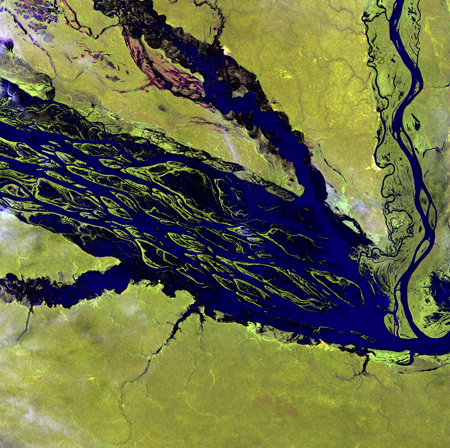
Fed by multiple waterways, Brazil’s Negro River is the Amazon’s largest tributary. The mosaic of partially-submerged islands visible in the channel disappears when seasonal downpours raise the water level. (Photo by NASA)





